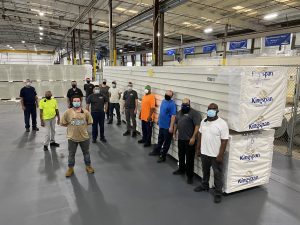Innovation can be a funny thing. Many ventures begin with a burning desire to innovate and find new ways to make things better. But once the business is up and running, it can become difficult to maintain that drive. Simply keeping the proverbial train on the tracks can take focus away from looking at ways to make things better. It’s easy to settle into a routine of spending too much time working in the business and not enough time working on the business.
For many, the events of the past year and a half created a need to innovate in order to survive. We all had to adapt and overcome a whole host of challenges at a wildly accelerated pace. Keeping the train on the tracks and stoking the fire of innovation were intertwined.
As we start to think about what the future looks like from here, we have an opportunity to continue learning and looking for new ways to operate instead of falling back into the ways of before. Since joining the Florida High Tech Corridor Council as CEO last year, my charge has been to honor our 25-year legacy while challenging the status quo every day. I encourage you to do the same.
In my experience, innovation is not so much a system, or a set of procedures, or even the result of research. Rather, when I arrived in this region, what stood out to me was how innovation had been adopted as a mindset. If you’ve ever heard someone say “yes, and” then you know what I mean. This seemingly simple phrase holds much deeper meaning. It enables us to look beyond what’s immediately in front of us — the next product launch, the next quarter, the next fiscal year — and look out at the horizon at what is happening around us. It also puts us in the mindset of building upon great ideas and imagining the possibilities, rather than focusing on what’s standing in our way.
For example, when two organizations that would not ordinarily be considered partners push past their natural inter-industry boundaries to help each other, it often leads to amazing breakthroughs. This intentional way to think about innovation leads to the approach that I am convinced will continue to drive innovation in Central Florida and continue our region’s growth as a high-tech hub.
That’s our mission at the Florida High Tech Corridor Council: to attract and grow high tech businesses and workforce throughout our 23-county region, including Volusia and Flagler Counties. No other organization in Florida offers the same unique regional perspective, and throughout our 25 years, it has become our greatest asset in facilitating collaborations between unlikely partners in academia, industry and economic development.
In fact, beyond adopting the innovative, “yes, and” mindset, if there were one thing I would tell the entrepreneurial leaders who want to advance our region’s economic diversification and prosperity, it would be to seek higher-level perspectives. Look beyond your immediate vantage point. Whether for partnership, funding or simply inspiration, I guarantee you will find something useful to model in your own community.
Second, I would urge you to connect with us. Our team is often asked, “How can I connect with The Corridor?” And our response is largely dependent upon the unique characteristics and goals of each organization. Sometimes, the best way to connect with us is to connect with the organizations we support. For example, Team Volusia is one of the many economic development organizations we collaborate with to encourage shared values and a culture of innovation across all 23 counties. We also partner with Embry-Riddle Aeronautical University in the areas of student entrepreneurship and business incubation and maintain great relationships with community leaders at Bethune-Cookman University, Daytona State College, and the City of Ormond Beach, just to name a few. If you connect with them, you connect with us.
Third, The Corridor Council also offers a few signature programs of our own, which emerged in areas where we saw a gap in our region’s cycle of innovation and made an investment based on the potential for new outcomes:
If you are technology-focused business with intellectual property or the desire to conduct research and would like to partner with one of our world-class universities, explore our Matching Grants Research Program (MGRP). The MGRP fosters applied research between high tech businesses and faculty and graduate students from the University of Central Florida, the University of South Florida, and the University of Florida. Not only does it help to augment companies’ R&D budgets and bring products to market, but it also supports the development of student researchers who may work full-time with the industry partner after graduation.
Help us develop next-generation STEM talent as a volunteer with stemCONNECT. Innovation cannot continue without the right talent in place. stemCONNECT inspires middle school and high school students to pursue in-demand STEM careers by connecting them with professionals in the field. With online video conferencing tools, subject-matter experts from across the region offer presentations and tours of their workplaces to teach students how their classroom lessons could lead to high tech career opportunities in Florida.
As the old saying goes, necessity is the mother of invention. Over the past year and a half, crisis has become the mother of innovation. Don’t take the experience for granted. YES, let’s learn from it AND build on what we’ve learned to move forward together.










